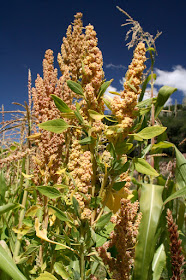Wageningen UR research has shown that it is possible to extract protein concentrates from quinoa using a method that is much milder and more sustainable than traditional extraction.
This method better preserves the functional properties of the protein and uses less than half the water, so that less energy is needed to dry the final product. Wageningen UR is looking for industry partners to upscale and run pilots on this technology.
The traditional method for isolating quinoa proteins consists of the following steps: grinding, degreasing the quinoa flour using hexane and caustic soda, concentrating the protein with hydrochloric acid, and finally washing, neutralising and freeze-drying. This results in a protein isolate with a protein content of over 90 percent. The disadvantage of this method is that it uses a lot of chemicals as well as large quantities of water, which then has to be removed through drying.
Less water, less energy
The new method, which has already been successfully applied to peas, consists of a dry separation step followed by an aqueous fractionation step. In the dry separation step the quinoa is carefully ground, following which the lighter high-protein fraction is separated using air. The aqueous fractionation step involves adding table salt and a small quantity of water to the isolate in order to dissolve the protein. Ultrafiltration is then used to remove the water and concentrate the protein.
“With this mild method, we obtain a protein fraction with nearly 60 percent protein content in the dry substance, and we only need to use 80 ml of water for 40 grams of quinoa flour, ie, approximately half of what is used in the traditional method. As a result drying also requires much less energy,” says Geraldine Avila Ruiz, PhD candidate at Wageningen UR Food & Biobased Research.
“The protein fraction is less pure than a traditional protein concentrate, but it is more natural thanks to the mild processing. This meets the industry’s increasing demand for more natural ingredients,” says Maarten Schutyser, associate professor at the Wageningen UR Laboratory of Food Process Engineering.
Application
The quinoa proteins obtained using this new technology are suitable for sports food, meat substitutes and other high-protein products. By varying the process conditions the properties can be fine-tuned to various applications. “For sports food for example, it is important to have a higher protein content, but for meat substitutes you can use a protein fraction that contains a lot of fibre,” say the researchers. With their expertise in the field of separation technology and proteins, they can develop customised quinoa proteins for various applications.
Publication
The results of this study have been featured in the article A hybrid dry and aqueous fractionation method to obtain protein-rich fractions from quinoa (Chenopodium quinoa Willd) (G Avila Ruiz et al) published in Food and Bioprocess Technology, May 2016.
Visit the Wageningen UR site HERE.
The traditional method for isolating quinoa proteins consists of the following steps: grinding, degreasing the quinoa flour using hexane and caustic soda, concentrating the protein with hydrochloric acid, and finally washing, neutralising and freeze-drying. This results in a protein isolate with a protein content of over 90 percent. The disadvantage of this method is that it uses a lot of chemicals as well as large quantities of water, which then has to be removed through drying.
 |
| Image: Lisa Cyr |
The new method, which has already been successfully applied to peas, consists of a dry separation step followed by an aqueous fractionation step. In the dry separation step the quinoa is carefully ground, following which the lighter high-protein fraction is separated using air. The aqueous fractionation step involves adding table salt and a small quantity of water to the isolate in order to dissolve the protein. Ultrafiltration is then used to remove the water and concentrate the protein.
“With this mild method, we obtain a protein fraction with nearly 60 percent protein content in the dry substance, and we only need to use 80 ml of water for 40 grams of quinoa flour, ie, approximately half of what is used in the traditional method. As a result drying also requires much less energy,” says Geraldine Avila Ruiz, PhD candidate at Wageningen UR Food & Biobased Research.
“The protein fraction is less pure than a traditional protein concentrate, but it is more natural thanks to the mild processing. This meets the industry’s increasing demand for more natural ingredients,” says Maarten Schutyser, associate professor at the Wageningen UR Laboratory of Food Process Engineering.
Application
The quinoa proteins obtained using this new technology are suitable for sports food, meat substitutes and other high-protein products. By varying the process conditions the properties can be fine-tuned to various applications. “For sports food for example, it is important to have a higher protein content, but for meat substitutes you can use a protein fraction that contains a lot of fibre,” say the researchers. With their expertise in the field of separation technology and proteins, they can develop customised quinoa proteins for various applications.
Publication
The results of this study have been featured in the article A hybrid dry and aqueous fractionation method to obtain protein-rich fractions from quinoa (Chenopodium quinoa Willd) (G Avila Ruiz et al) published in Food and Bioprocess Technology, May 2016.
Visit the Wageningen UR site HERE.
The Global Miller
This blog is maintained by The Global Miller staff and is supported by the magazine GFMT
which is published by Perendale Publishers Limited.
For additional daily news from milling around the world: global-milling.com

No comments:
Post a Comment